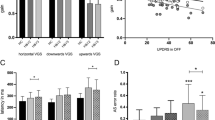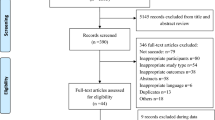Abstract
Saccades are a potentially important biomarker of Huntington disease (HD) progression, as saccadic abnormalities can be detected both cross-sectionally and longitudinally. Although vertical saccadic impairment was reported decades ago, recent studies have focused on horizontal saccades. This study investigated antisaccade (AS) and memory guided saccade (MG) impairment in both the horizontal and vertical directions in individuals with the disease-causing CAG expansion (CAG+; n = 74), using those without the expansion (CAG−; n = 47) as controls. Percentage of errors, latency, and variability of latency were used to measure saccadic performance. We evaluated the benefits of measuring saccades in both directions by comparing effect sizes of horizontal and vertical measures, and by investigating the correlation of saccadic measures with underlying gray matter loss. Consistent with previous studies, AS and MG impairments were detected prior to the onset of manifest disease. Furthermore, the largest effect sizes were found for vertical saccades. A subset of participants (12 CAG−, 12 premanifest CAG+, 7 manifest HD) underwent magnetic resonance imaging, and an automated parcellation and segmentation procedure was used to extract thickness and volume measures in saccade-generating and inhibiting regions. These measures were then tested for associations with saccadic impairment. Latency of vertical AS was significantly associated with atrophy in the left superior frontal gyrus, left inferior parietal lobule, and bilateral caudate nuclei. This study suggests an important role for measuring vertical saccades. Vertical saccades may possess more statistical power than horizontal saccades, and the latency of vertical AS is associated with gray matter loss in both cortical and subcortical regions important in saccade function.

Similar content being viewed by others
References
Huntington’s Disease Collaborative Research Group (1993) A novel gene containing a trinucleotide repeat that is expanded and unstable on Huntington’s disease chromosomes. Cell 72:971–983
Kirkwood SC, Siemers E, Hodes ME, Conneally PM, Christian JC, Foroud T (2000) Subtle changes among presymptomatic carriers of the Huntington’s disease gene. J Neurol Neurosurg Psychiatry 69:773–779
Paulsen JS, Hayden M, Stout JC, Langbehn DR, Aylward E, Ross CA, Guttman M, Nance M, Kieburtz K, Oakes D, Shoulson I, Kayson E, Johnson S, Penziner E (2006) Preparing for preventive clinical trials: the predict-HD study. Arch Neurol 63:883–890
Blekher T, Johnson SA, Marshall J, White K, Hui S, Weaver M, Gray J, Yee R, Stout JC, Beristain X, Wojcieszek J, Foroud T (2006) Saccades in presymptomatic and early stages of Huntington disease. Neurology 67:394–399
Golding CV, Danchaivijitr C, Hodgson TL, Tabrizi SJ, Kennard C (2006) Identification of an oculomotor biomarker of preclinical Huntington disease. Neurology 67:485–487
Aylward EH, Sparks BF, Field KM, Yallapragada V, Shpritz BD, Rosenblatt A, Brandt J, Gourley LM, Liang K, Zhou H, Margolis RL, Ross CA (2004) Onset and rate of striatal atrophy in preclinical Huntington disease. Neurology 63:66–72
Paulsen JS, Nopoulos PC, Aylward E, Ross CA, Johnson H, Magnotta VA, Juhl A, Pierson RK, Mills J, Langbehn D, Nance M (2010) Striatal and white matter predictors of estimated diagnosis for Huntington disease. Brain Res Bull 82:201–207
Leigh RJ, Newman SA, Folstein SE, Lasker AG, Jensen BA (1983) Abnormal ocular motor control in Huntington’s disease. Neurology 33:1268–1275
Antoniades CA, Altham PM, Mason SL, Barker RA, Carpenter R (2007) Saccadometry: a new tool for evaluating presymptomatic Huntington patients. Neuroreport 18:1133–1136
Blekher TM, Yee RD, Kirkwood SC, Hake AM, Stout JC, Weaver MR, Foroud TM (2004) Oculomotor control in asymptomatic and recently diagnosed individuals with the genetic marker for Huntington’s disease. Vision Res 44:2729–2736
Hicks SL, Robert MP, Golding CV, Tabrizi SJ, Kennard C (2008) Oculomotor deficits indicate the progression of Huntington’s disease. Prog Brain Res 171:555–558
Lasker AG, Zee DS (1997) Ocular motor abnormalities in Huntington’s disease. Vision Res 37:3639–3645
Rupp J, Blekher TM, Jackson JG, Beristain X, Marshall J, Hui SL, Wojcieszek JM, Foroud T (2010) Progression in prediagnostic Huntington disease. J Neurol Neurosurg Psychiatry 81:379–384
Antoniades CA, Xu Z, Mason SL, Carpenter RH, Barker RA (2010) Huntington’s disease: changes in saccades and hand-tapping over 3 years. J Neurol 257:1890–1898
Bohanna I, Georgiou-Karistianis N, Hannan AJ, Egan GF (2008) Magnetic resonance imaging as an approach towards identifying neuropathological biomarkers for Huntington’s disease. Brain Res Rev 58:209–225
Hersch SM, Gevorkian S, Marder K, Moskowitz C, Feigin A, Cox M, Como P, Zimmerman C, Lin M, Zhang L, Ulug AM, Beal MF, Matson W, Bogdanov M, Ebbel E, Zaleta A, Kaneko Y, Jenkins B, Hevelone N, Zhang H, Yu H, Schoenfeld D, Ferrante R, Rosas HD (2006) Creatine in Huntington disease is safe, tolerable, bioavailable in brain and reduces serum 8OH2’dG. Neurology 66:250–252
Tabrizi SJ, Langbehn DR, Leavitt BR, Roos RA, Durr A, Craufurd D, Kennard C, Hicks SL, Fox NC, Scahill RI, Borowsky B, Tobin AJ, Rosas HD, Johnson H, Reilmann R, Landwehrmeyer B, Stout JC (2009) Biological and clinical manifestations of Huntington’s disease in the longitudinal TRACK-HD study: cross-sectional analysis of baseline data. Lancet Neurol 8:791–801
Rosas HD, Salat DH, Lee SY, Zaleta AK, Hevelone N, Hersch SM (2008) Complexity and heterogeneity: what drives the ever-changing brain in Huntington’s disease? Ann N Y Acad Sci 1147:196–205
Rosas HD, Liu AK, Hersch S, Glessner M, Ferrante RJ, Salat DH, van der Kouwe A, Jenkins BG, Dale AM, Fischl B (2002) Regional and progressive thinning of the cortical ribbon in Huntington’s disease. Neurology 58:695–701
Rosas HD, Salat DH, Lee SY, Zaleta AK, Pappu V, Fischl B, Greve D, Hevelone N, Hersch SM (2008) Cerebral cortex and the clinical expression of Huntington’s disease: complexity and heterogeneity. Brain 131:1057–1068
Blekher T, Weaver MR, Cai X, Hui S, Marshall J, Jackson JG, Wojcieszek J, Yee RD, Foroud TM (2009) Test–retest reliability of saccadic measures in subjects at risk for Huntington disease. Invest Ophthalmol Vis Sci 50:5707–5711
Bond CE, Hodes ME (1996) Direct amplification of the CAG repeat of huntingtin without amplification of CCG. Clin Chem 42:773–774
Huntington Study Group (1999) Unified Huntington’s Disease Rating Scale-99. Huntington Study Group, Rochester
Langbehn DR, Brinkman RR, Falush D, Paulsen JS, Hayden MR (2004) A new model for prediction of the age of onset and penetrance for Huntington’s disease based on CAG length. Clin Genet 65:267–277
Paulsen JS, Langbehn DR, Stout JC, Aylward E, Ross CA, Nance M, Guttman M, Johnson S, MacDonald M, Beglinger LJ, Duff K, Kayson E, Biglan K, Shoulson I, Oakes D, Hayden M (2008) Detection of Huntingtons disease decades before diagnosis: the predict-HD study. J Neurol Neurosurg Psychiatry 79:874–880
Cohen J (1992) A power primer. Psychol Bull 112:155–159
Jack CR Jr, Bernstein MA, Fox NC, Thompson P, Alexander G, Harvey D, Borowski B, Britson PJ, Whitwell L, Ward C, Dale AM, Felmlee JP, Gunter JL, Hill DL, Killiany R, Schuff N, Fox-Bosetti S, Lin C, Studholme C, DeCarli CS, Krueger G, Ward HA, Metzger GJ, Scott KT, Mallozzi R, Blezek D, Levy J, Debbins JP, Fleisher AS, Albert M, Green R, Bartzokis G, Glover G, Mugler J, Weiner MW (2008) The Alzheimer’s Disease Neuroimaging Initiative (ADNI): MRI methods. J Magn Reson Imaging 27:685–691
Dale AM, Fischl B, Sereno MI (1999) Cortical surface-based analysis. I. Segmentation and surface reconstruction. Neuroimage 9:179–194
Fischl B, Sereno MI, Dale AM (1999) Cortical surface-based analysis. II: inflation, flattening, and a surface-based coordinate system. Neuroimage 9:195–207
Fischl B, Dale AM (2000) Measuring the thickness of the human cerebral cortex from magnetic resonance images. Proc Natl Acad Sci USA 97:11050–11055
Fischl B, Salat DH, Busa E, Albert M, Dieterich M, Haselgrove C, van der Kouwe KA, Killiany R, Kennedy D, Klaveness S, Montillo A, Makris N, Rosen B, Dale AM (2002) Whole brain segmentation: automated labeling of neuroanatomical structures in the human brain. Neuron 33:341–355
McDowell JE, Dyckman KA, Austin BP, Clementz BA (2008) Neurophysiology and neuroanatomy of reflexive and volitional saccades: evidence from studies of humans. Brain Cogn 68:255–270
Stout JC, Weaver M, Solomon AC, Queller S, Hui S, Johnson SA, Gray J, Beristain X, Wojcieszek J, Foroud T (2007) Are cognitive changes progressive in prediagnostic HD? Cogn Behav Neurol 20:212–218
Dias EC, Kiesau M, Segraves MA (1995) Acute activation and inactivation of macaque frontal eye field with GABA-related drugs. J Neurophysiol 74:2744–2748
Keating EG, Gooley SG, Pratt SE, Kelsey JE (1983) Removing the superior colliculus silences eye movements normally evoked from stimulation of the parietal and occipital eye fields. Brain Res 269:145–148
Lynch JC, Graybiel AM, Lobeck LJ (1985) The differential projection of two cytoarchitectonic subregions of the inferior parietal lobule of macaque upon the deep layers of the superior colliculus. J Comp Neurol 235:241–254
Pare M, Wurtz RH (2001) Progression in neuronal processing for saccadic eye movements from parietal cortex area lip to superior colliculus. J Neurophysiol 85:2545–2562
Kloppel S, Draganski B, Golding CV, Chu C, Nagy Z, Cook PA, Hicks SL, Kennard C, Alexander DC, Parker GJ, Tabrizi SJ, Frackowiak RS (2008) White matter connections reflect changes in voluntary-guided saccades in pre-symptomatic Huntington’s disease. Brain 131:196–204
Bhidayasiri R, Plant GT, Leigh RJ (2000) A hypothetical scheme for the brainstem control of vertical gaze. Neurology 54:1985–1993
Pflugshaupt T, Nyffeler T, von Wartburg R, Hess CW, Muri RM (2008) Loss of exploratory vertical saccades after unilateral frontal eye field damage. J Neurol Neurosurg Psychiatry 79:474–477
Nopoulos PC, Aylward EH, Ross CA, Johnson HJ, Magnotta VA, Juhl AR, Pierson RK, Mills J, Langbehn DR, Paulsen JS (2010) Cerebral cortex structure in prodromal Huntington disease. Neurobiol Dis 40:544–554
Pavese N, Gerhard A, Tai YF, Ho AK, Turkheimer F, Barker RA, Brooks DJ, Piccini P (2006) Microglial activation correlates with severity in Huntington disease: a clinical and PET study. Neurology 66:1638–1643
Alexander GE, Crutcher MD (1990) Functional architecture of basal ganglia circuits: neural substrates of parallel processing. Trends Neurosci 13:266–271
Watanabe K, Lauwereyns J, Hikosaka O (2003) Neural correlates of rewarded and unrewarded eye movements in the primate caudate nucleus. J Neurosci 23:10052–10057
Hikosaka O, Takikawa Y, Kawagoe R (2000) Role of the basal ganglia in the control of purposive saccadic eye movements. Physiol Rev 80:953–978
Acknowledgments
We gratefully acknowledge the individuals who participated in this study. We also thank Xabier Beristain, Jeanine Marshall, Marjorie Weaver, Michele Beal, Veronique Bragulat, and Courtney Robbins who provided expertise and technical support for the study. This work was supported by National Institute of Health Grants R01NS042659, R21NS060205, N01NS-3-2357, M01RR-00750, UL1RR025761, P30AG10133-18S1, a pilot Grant from the Center for Neuroimaging at Indiana University School of Medicine, a Research Support Fund Grant from Indiana University-Purdue University Indianapolis, and support from the CHDI Foundation, project 1214.
Conflict of interest
The authors declare that they have no conflict of interest.
Author information
Authors and Affiliations
Corresponding authors
Electronic supplementary material
Below is the link to the electronic supplementary material.
Rights and permissions
About this article
Cite this article
Rupp, J., Dzemidzic, M., Blekher, T. et al. Comparison of vertical and horizontal saccade measures and their relation to gray matter changes in premanifest and manifest Huntington disease. J Neurol 259, 267–276 (2012). https://doi.org/10.1007/s00415-011-6172-0
Received:
Revised:
Accepted:
Published:
Issue Date:
DOI: https://doi.org/10.1007/s00415-011-6172-0




